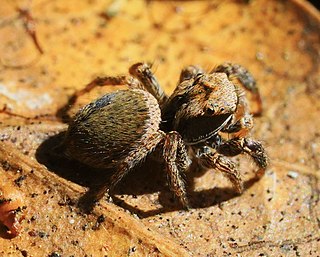
Chalcoscirtus lepidus is a species of jumping spider in the genus Chalcoscirtus that has been found in Afghanistan, Iran, Tajikistan,Turkmenistan and Uzbekistan. The spider was first described in 1996 by Wanda Wesołowska, although the first male was identified three years later. The spider is small, with a carapace between 1.06 and 1.2 mm long and an abdomen between 1.03 and 2.2 mm long. The female is larger and lighter than the male and has three narrower stripes on the back while the male has a large scutum. In both cases, the carapace is plain. The scutum and lack of pattern on the carapace help distinguish the spider from related species. It can also be identified by its copulatory organs, particularly the long curved embolus on the male and the position of the copulatory openings on the female epigyne, which differ from the otherwise similar Chalcoscirtus infimus.

Habronattus pyrrithrix is a species of jumping spider in the family Salticidae. It is found in the southwestern United States and western Mexico.

Phidippus insignarius is a species of jumping spider in the family Salticidae. It is found in the United States.

Platycryptus arizonensis is a species of jumping spider in the family Salticidae. It is found in the United States.

Phidippus texanus is a species of jumping spider in the family Salticidae. It is found in the United States and Mexico.

Habronattus orbus is a species of jumping spider in the family Salticidae. It is found in the United States.

Habronattus texanus is a species of jumping spider in the family Salticidae. It is found in the United States and Mexico.

Habronattus tarsalis is a species of jumping spider in the family Salticidae. It is found in the United States and has been introduced into Hawaii.

Phidippus carolinensis is a species of jumping spider. It is found in the United States and Mexico.

Habronattus conjunctus is a species of jumping spider in the family Salticidae. It is found in the United States and Mexico.

Habronattus carolinensis is a species of jumping spider in the family Salticidae. It is found in the United States and Canada?.
Habronattus ocala, the ocala jumper, is a species of jumping spider in the family Salticidae. It is found in the United States.

Marpissa formosa is a species of jumping spider. It is found in the eastern United States.

Habronattus formosus is a species of jumping spider in the family Salticidae. It is found in the United States.

Habronattus dossenus is a species of jumping spider. It is found in Mexico and the southwestern United States. They are most well known for their unique dynamic signals such as scraping, thumping, buzzing, and/or buzzing. It has been shown that there is a strong correlation between their seismic (vibration) signals and motion signals, suggesting that H. dossenus utilize inter-signal interactions to create integrative communication. These seismic signals can range from rapid phasic sounds that are less than 200 milliseconds long to long phrases lasting multiple seconds.
Habronattus cuspidatus is a species of jumping spider in the family Salticidae. It is found in the United States and Canada.

Habronattus oregonensis is a species of jumping spider in the family Salticidae. It is found in North America.

Phidippus comatus is a species of jumping spider in the family Salticidae. It is found in North America.

Phidippus apacheanus is a species of jumping spider in the family Salticidae. It is found in the United States, Mexico, and Cuba.

Hentzia palmarum, the common hentz jumper, is a species of jumping spider in the family Salticidae. It is found in North America, Bermuda, the Bahamas, and Cuba.























